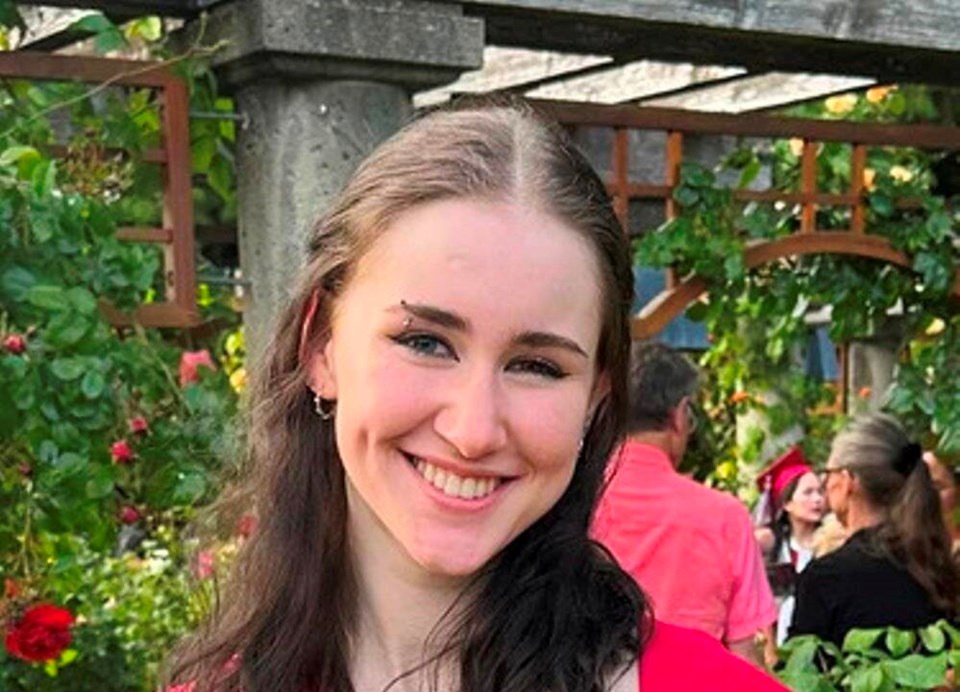On a Tuesday evening in January 2024, three first-year University of Victoria students gathered in a third-floor bathroom of the Sir Arthur Currie residence building and used a paper straw cut in three pieces to snort a toxic mix of fentanyl-laced cocaine.
For one of the three, 18-year-old Sidney McIntyre-Starko, it was the first time she’d ever tried a street drug, according to a 123-page independent report released Thursday. It was also the last.
Sidney overdosed and suffered cardiac arrest. She was pronounced dead Jan. 26, three days after the incident. A coroner’s inquest into her death is scheduled to begin April 28.
Commissioned by the university, the new report by lawyer Bob Rich, a former Abbotsford police chief, says the student “likely would not have died” if the response had been different.
Security officers who responded failed to identify the symptoms of an overdose and administer nasal naloxone to reverse the effects of the toxic drugs until it was too late, it says.
“The response by the university to this medical crisis that night was not well coordinated or thought out,” the report says. “Sidney, her family, the other students who overdosed, and the students who tried to help, were not properly cared for that night.”
A day prior to the fatal incident, two of the girls apparently rubbed some of the greyish-white powder from a vial on their gums, “likely to determine if it was cocaine,” and had no reaction, says the report’s timeline.
The next night, when the three girls inhaled lines of the drug with plans to watch a movie later, Sidney collapsed in the dimly lit dorm room while the second girl fell in the hallway just outside the door with an audible thud.
The first of the security officers arrived in just under four minutes and were told by witnesses who arrived after the fact that the girls’ symptoms, including physical jerking, were seizures. That led security and the 911 operator to believe the girls, who were unconscious and in respiratory distress, didn’t need CPR.
“The problem is that fentanyl can cause seizure-like symptoms, and hypoxia, the lack of oxygen in the body’s tissues if there is suppressed breathing, can cause a seizure,” says the report.
The third intoxicated girl phoned 911 but did not disclose the drug use to security officers or the 911 operator. Instead, she told the first witness that the unconscious girl in the hallway was sleeping, as she tried to drag her into the same room as Sidney, and she told first responders that her friends collapsed and started having seizures after running around “playing.”
Meanwhile, the girls were turning blue, according to witnesses.
Nine minutes later — a full 13 minutes after the girls collapsed — security officers were told that a drug overdose was likely and nasal naloxone was administered to both students.
It was the first opioid overdose the security officers had attended and they were not equipped with oxygen — security guards had carried it up until February 2023, when it was discontinued.
CPR was only started after Sidney went into cardiac arrest and ceased to have a pulse, 15 minutes after her collapse, the report says.
When Sidney was taken by ambulance and put on life support at Royal Jubilee Hospital, the other two students — who were vomiting — were left behind to be cared for by other students until security officers were called again and they were taken to hospital.
UVic staff did not call Sidney’s emergency contacts. Sidney’s brother, who also attended UVic, was contacted by a witness, and when he went to the hospital, it took him “several hours” to locate Sidney, who was on a ventilator. By the time he could contact his parents, it was too late for Sidney’s mother to get to Victoria by plane or ferry.
Several university administrators were briefed on what happened but no one contacted the family because they imagined someone else was doing that, the investigation found. No university official went to the hospital that night.
The report concludes that university senior leaders worked in silos, with no one incident commander in charge to co-ordinate responses and communication.
“Senior staff at the university initially believed that there were no significant delays in providing appropriate first aid to the students,” says the report. “However, once the meeting with the family occurred on Feb. 1 [2024], it was clear that the university needed to know exactly what happened. The only way to do that in a timely way was to do an investigation.”
Sidney’s parents, Dr. Caroline McIntyre and Kenton Starko of Vancouver, collected emergency-response transcripts and recordings and assembled a more accurate timeline than the university had acquired. McIntyre didn’t meet with UVic president Kevin Hall until April 2, 2024.
Rich, who spent six months interviewing more than 50 people, makes 18 recommendations, including calls for changes in culture, such as more co-ordination between university teams and senior leaders, and more focus on the safety needs of students and residence staff.
It also recommends changes in response to critical incidents, including the creation of a “person in charge” position as well as a trained family liaison who can answer questions.
It recommends that by September, residence staff be trained in basic first aid, including administering naloxone, and that the overdose-reversing drug be brought by trained individuals to special events and field trips.
The campus security director raised concerns before the incident about a “noted increase” in overdoses on and around campus, Rich notes. But students weren’t advised about them, or even about the Jan. 23 overdoses on campus in the days after the incident.
The students involved in that incident knew about fentanyl but likely thought they’d be safe using the drugs together, the report says.
Another recommendation is to better inform students about the toxic drug crisis, including the fact the federal government has a Good Samaritan protocol that protects people who call first responders about overdoses.
The report notes that the current UVic non-academic misconduct policy says students can be sanctioned for the use or possession of illicit drugs.
If UVic had an amnesty policy, it might have encouraged more candor in response to questions by the security officers as to why the girls were unconscious, and saved Sidney’s life, said Rich.
The evening’s outcome also might have been different if UVic had clearly warned all students that 80 per cent of illegal street drugs are contaminated with fentanyl, said Rich.
UVic president Kevin Hall in a phone interview Thursday said he and the university’s executive leadership team will oversee implementation of all the recommendations to ensure “Sidney’s death leads to meaningful and lasting change.” Hall said student-related recommendations will be implemented by September.
He said at the time of Sidney’s death, some harm-reduction supplies were available at the university, along with messages advising students not to use toxic drugs, and there was an assumed “understanding of amnesty” for drug incidents, but clearly more work needs to be done as outlined in the recommendations.
The university president thanked the McIntyre-Starko family for speaking out and sparking a broader conversation across post-secondary institutions and the province about the toxic-drug-overdose crisis. To future parents sending their children to UVic, Hall said the university is a safe institution but is working to continually improve.
He pointed to steps UVic has already taken, including installing nasal naloxone kits across campus, and working with emergency responders to improve wayfinding signage.
“This will take time, and we’re committed to the work ahead.”
To read the report, go to: .



